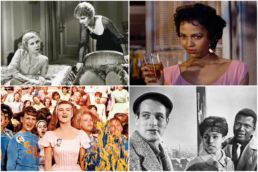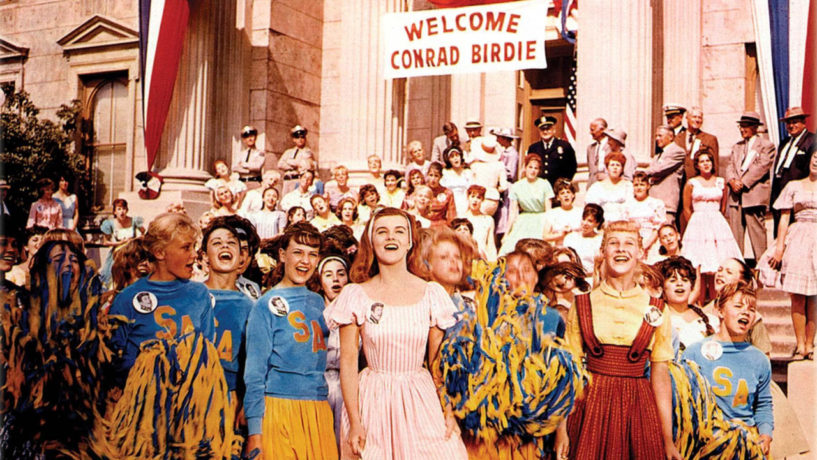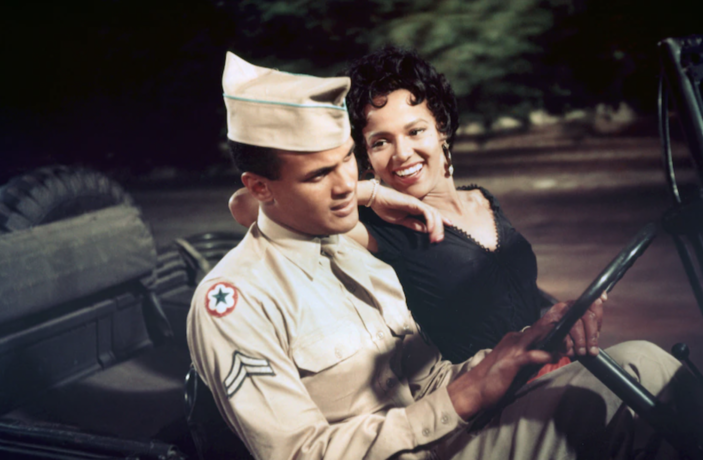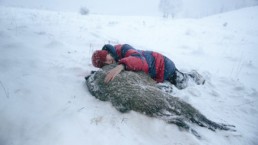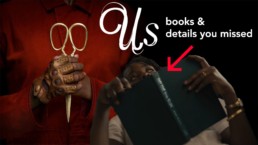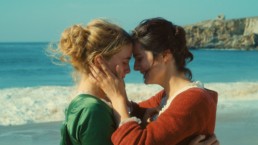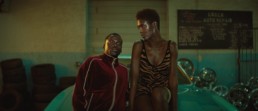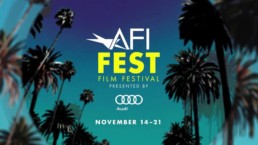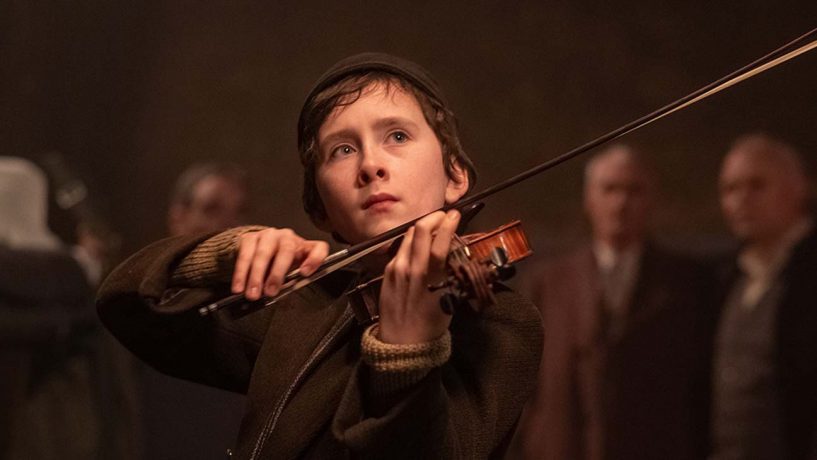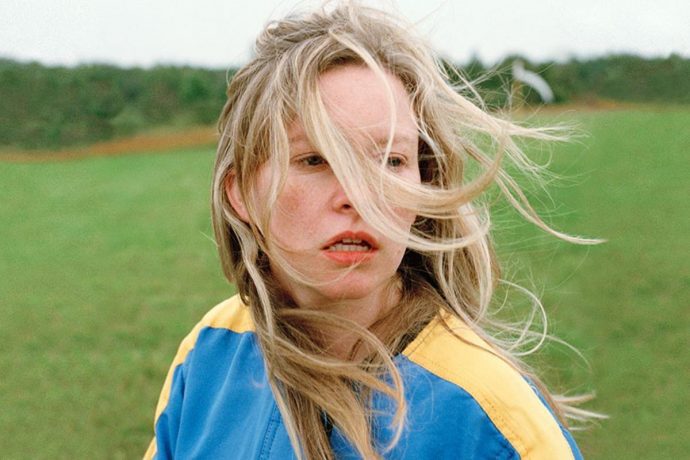2023 TCM Classic Film Festival: What We Saw
Another TCM Classic Film Festival has come and gone, leaving behind more great memories from one of our favorite film festivals of the year. Read on to see which films writer H. Nelson Tracey saw from the festival.
Paris Blues (1961)
Special Guest: Joie Lee (Crooklyn, Do the Right Thing) | Presented on 35mm
Paul Newman and Sidney Poitier play two jazz musicians operating a Paris nightclub who fall for a pair of American tourists (Joanne Woodward and Diahann Carroll) in this romantic music-driven drama. My favorite viewing of this year’s film festival, the class act performances of the entire ensemble of all-stars make this captivating beyond words.
This is combined with exceptional jazz music, including a performance by Louis Armstrong as a fictional version of himself! The show-stopping number features Armstrong playing alongside Newman and Poitier, which has to be seen to be believed and drew huge applause from the TCM audience. Even when jazz is scored only, the storyline builds a newfound appreciation for the sophistication of the genre; Duke Ellington received an Oscar nomination for his original score of the film.
Paris Blues has some elements that feel of its time, and some that feel notably progressive for the early 1960s. Paul Newman is given a significantly richer character arc than Sidney Poitier, and I think if this movie were to be remade (it absolutely could and should), you would swap the emphases: Newman’s character is trying to be taken seriously as a composer, not just a performer, and dealing with the infinitely relatable struggle of an artist trying to break through while not letting their life slip by chasing a dream.
Joanna Woodward, who was married to Newman in real life, represents the conflicting choice that falling in love presents and deciding between love and a dream is wholly compelling. Their chemistry is off the charts and is no doubt influenced by their real-life love - what a beautiful thing to see soulmates on celluloid.
Meanwhile, Poitier and Carroll are caught between the decision to stay in Paris, where being Black is significantly more liberating than the United States, or returning home where family is and where contributing to civil rights has a sense of vocation at the time. For a movie made still within the censorship era, Paris Blues threads this debate with remarkable deftness.
Based on a novel, one of the major changes discussed in the pre-film conversation was that the censorship of the era would not allow an interracial couple to be seen onscreen, even though such behavior would’ve been acceptable in Paris at the time, putting the romantic options into a specific pairing.
However, the movie dances around this by having early moments where it seems the couples will end up with reverse matches, which was the filmmaker’s way of nodding toward this original idea while still drawing within the lines. It creates a fascinating tension in the early flirtations between all four leads.
It’s never explained how Woodward and Carroll became friends nor why they’re traveling together: an updated version would give the women more development, but they are remarkably interesting characters even without that information.
From start to finish, Paris Blues feels like exactly the kind of classic this film festival is for: an underseen gem starring some of the best stars of all time, with an emotionally rich narrative and simultaneously timeless and timely themes.
This TCM screening was preceded by a conversation with Joie Lee, writer of Crooklyn and star of many films including Do The Right Thing. Growing up with a jazz musician father, this was a film Lee remembered well seeing on weekend television as a kid, and she gushed about the use of music and beauty of Poitier and Carroll. She said her father (Spike Lee) claimed improvisational jazz was “the highest art form” which was a perfect primer to appreciate the artistry of the film.
A few years ago when I saw Stage Door at TCMFF it completely changed my perception and empathy for actors, for the better. In some ways, I feel this film did the same for my perception and admiration for jazz music.
The Wiser Sex (1932)
Special Guest: historian Cari Beauchamp | Presented on 35mm
A great TCMFF experience is not complete without at least one “Pre-Code” flick. The Pre-Code Era lasted from 1927-1934 and was a brief period where the invention of sound was in place, but the strict censor laws that strangled Hollywood for over 30 years were not yet implemented.
As you can imagine, these are popular pictures for the TCM crowd: festival programmers described the “Pre-Code Bump” in attendance for every Pre-Code screening. What’s equally unique is that the films TCM brings for this are usually underseen classics that are rare or hard to find.
The Wiser Sex is certainly such: shown on a 35mm print not yet widely available, for nearly everyone in the audience this was a first-time discovery. Further proof of its obscurity: prior to this year’s festival only only 47 on IMDb had rated this title and only 8 on Letterboxd!
Film Historian Cari Beachamp gave a fantastic introduction contextualizing the many famous stars in this picture of the Golden Age: Claudette Colbert (prior to winning an Oscar), Franchot Tone (his first feature), Lilyan Tashman, and Melvyn Douglas (whose career lasted all the way until the early 1980s and netted him two Oscars).
She also talked about the damning impact the Code would have on movies, especially the roles of women in society and the rigid social norms that would have a generational impact on female autonomy. For screenings like this, the historical context is equally as powerful as the picture itself.
And how is The Wiser Sex? A two-crossing dame frames her virtuous ex as a murderer, forcing his current love interest to go undercover, uncover the plot, and reveal the true villains using nothing more than her cunning wit. It’s a job for The Wiser Sex: our heroine Claudette Colbert declares “men are stupid” and takes matters into her own hands to save the day.
It’s this type of brash talk and societal norm-breaking that make Pre-Code pictures so compelling: it makes us hyper-aware of just how strict censorship became in the United States when you see a movie that is uninhibited by it.
In addition to some risque components, there is no shortage of boozing in this film which would quickly become corked by the censors, along with extramarital sex and other so-called “deviant” behavior.
In festivals past, the rediscovered Pre-Code film Merrily We Go To Hell (1932) shortly thereafter received a Criterion release, so don’t be surprised if this movie gets added to that Collection in the coming months.
Bye Bye Birdie (1963)
Special Guest: Ann-Margret
Cinephiles broadly speaking tend to celebrate the movies of the post-censorship era in the late 1960s and early 1970s that rebelled against the more traditional fare of the decades prior and ushered in a new era of gritty and raw filmmaking that permanently changed the course of movie history.
But in the modern love of this type of cinema, it’s easy to forget to check out exactly what these movies were rebelling against the cozy, all-ages pop entertainment that was primarily made up of musicals and TV westerns. Bye Bye Birdie fits squarely into the former category. It’s a bubblegum musical that feels like the quintessential Camelot Era musical, with silly ditties making up the entire runtime and family values (by 1963’s standards) winning the day.
What’s most interesting is that the movie is very much a self-aware satire, with the titular Birdie being a very obvious stand-in for Elvis (whose manager refused to let him play himself in this movie) and the fervor of young girls obsessed with the pop star being poked fun at in this entire narrative. I can’t imagine a movie today taking something so current (it was based on Elvis’s drafting) and making it into a musical. It speaks to how these were the tentpoles of their era.
It also makes me think about how it feels like this era of history, one that I’ve spent my entire life studying through the dearth of a pop culture devoted to it, was already solidifying its narrative as it happened. When you see this after a contemporary take on the era, like 2022’s Elvis, the wild reality is the new version isn’t saying anything that wasn’t widely recognized in the time of its release.
Compared to more revered musicals like The Sound of Music or West Side Story, Bye Bye Birdie feels much less essential but in that sense is a good representation of mass media for its time. Largely, the movie hasn’t aged because its musical numbers are admittedly, not particularly catchy. The story is relatively slight: music numbers feel rather pedestrian by comparison to the bigger classics.
But there’s undeniable entertainment to be had. There is one particular number featuring Janet Leigh that has some funny phallic moments. Dick Van Dyke’s singing in the garden at night feels like a first pass at what would be iconized in Mary Poppins a few years later. But by and large, these are not exactly karaoke favorites nor resung tunes.
However, the influence of this movie can be felt in numerous ways. Watching the very opening and the dance hall number, I was reminded that Spike Lee described seeing this movie with his mother and cited it as an influence; with that, you can see how the opening directly influenced Do the Right Thing and how the dance hall number largely resembles a sequence in Malcolm X.
I have no way of proving this but the father figure of the film played by Paul Lynde seems to clearly resemble Steve Carell and I wouldn’t be surprised if Carell pulled some of his comedic stylings, particularly his earlier work, from Lynde’s hammy performance.
The film played through the roof for the audience in the TCL Chinese theater with applause after every number. Personal opinions aside, the movie looked spectacular on a crisp colorful DCP, particularly the iconic opening number.
And that brings up the last component worth highlighting: Ann Margret, the film’s young star who graced the audience with her appearance, looking thrilled to be welcomed with open arms by loving fans. I primarily know her as a 1970s actress with Oscar-nominated turns in Tommy and Carnal Knowlege. But I learned just how big she was at the start of the 1960s as a magnetic singer and soon-to-be sex icon.
In this film, she plays the teen obsessed with Birdie, and ironically, this would lead her to actually co-star with the real Elvis Presley the very next year in Viva Las Vegas. And her charisma was so strong that Elvis’s manager forced the studio to cut songs where she upstaged The King. Now that’s a director’s cut I would like to get eyes on.
Carmen Jones (1954)
Special Guests: historian Donald Bogle, Robert Osborne award recipient, Deborah Martin Chase (producer) Louis Gossett Jr. (Oscar winner, An Officer and a Gentleman)
In a complete tonal shift from the bubblegum pop of Bye Bye Birdie comes the all-Black cast adaptation of the Opera “Carmen,” featuring a historic performance by Dorothy Dandridge, who became the first Black performer of either gender nominated for a Leading Performance Oscar, when she was nominated for Best Actress in 1954.
The movie modernizes the Carmen opera to a contemporary era but retains the grandeur of the stage music, most of which is recognizable even to those unfamiliar with the source. Looking gorgeous on Technicolor, the movie shines on the big screen and took me back to my youth of going to see Opera Colorado performances (and participating in a few, a story for another day).
It had to have been progressive and interesting for 1950s audiences to see a film of this budget and scale without a single white face on camera. Director Otto Preminger would try and replicate this success (it was a box office smash) with Porgy & Bess, but to lesser results.
I didn’t realize until after the film that none of the actors are singing themselves but are dubbed, which makes more sense in hindsight, but is an example of what was once a common technique that in a post-2012 Les Miserables world is largely frowned upon in movie musicals. While the film feels more stagey than some of the more cinematic musicals of its era, the daring performances especially from Dandrige and Harry Belafonte are undeniable.
What made this screening special was not only the film but that it was preceded by the annual Robert Osbourne Award, which goes to an individual whose lifetime contributions to film history are worth applauding (past recipients include Leonard Maltin and Martin Scorsese).
This year’s recipient was Donald Bogle, who is the premier history of African-American cinema. In a moving tribute to Bogle, TCM host Ben Mankiewicz introduced a wonderful clip reel showcasing Bogle’s career highlights. Bogle’s longtime friend, producer Deborah Martin Chase, gave a moving speech showing her love and admiration for his career and their friendship.
Then, Oscar-winning actor Louis Gossett Jr., the first Black actor to win Best Supporting Actor, made an appearance (at the age of 86) and gave a commanding speech that paid tribute to Bogle and his indelible mark; without Donald Bogle, Black Hollywood would not have been properly cataloged and many of the contributors would’ve been lost in time.
Finally, Bogle took the stage to multiple standing ovations, professed his great thanks, and introduced his favorite movie of all time, Carmen Jones. With legendary guests, enthusiastic audiences, and outstanding programming, it is moments like this that make the TCM Film Festival a truly unforgettable event year after year.
It's Hunters vs Animals in the Polish Murder-Mystery 'Spoor'
This review originally ran on November 28, 2017, during the AFI Film Festival
The official selection for 2017 Academy Awards consideration from Poland, Spoor, depicts a small hunting-obsessed community. One older woman (a funny, truly original Agnieszka Mandat-Grabka) decides to speak up against the disturbing atrocities committed on animals. At the same time and eerily enough, many prominent hunters in the community become the hunted themselves. It appears that the animals they kill may be retaliating, but the truth is unclear.
As an animal rights advocate myself, this film was high on my list to check out at AFI this year. Unfortunately, most of the film moves at an uncompelling pace and more often than not, failed to capture my attention. Rather than providing any new perspective on the debate of human-animal relationships, it takes the most extreme black-and-white approach to the conflict. The good guys are animal lovers, vegetarians, and would never kill an animal. The bad guys are warmongering, bloodthirsty meat-eaters. This logic creates a very easy and cohesive narrative but makes the problem so simple that any application to the much more complex real-world is impossible. It does the animal-loving community no favors.
Eventually, 'Spoor' does reveal a major twist and yet, once again, keeps the simple narrative that animal lovers are good and hunters are evil even though it is clear that there is much more moral ambiguity in this small town.
Additionally, the pace at which the film moves is unbearably slow. If it had moved at a more brisk pace, perhaps the film could have felt tense and thrilling. Instead, each of the murders is so spaced out, it isn’t hard to forget who the person is that is dying. The animals are supposedly killing these men, but even that mystery ends up being more confusing than gripping.
If Spoor does have a silver lining, it comes from the lead performance. Agnieszka Mandat-Grabka feels a bit like a batty Mrs. Weasley, an endearing maternal figure who will not be silenced by the patriarchal and archaic traditions of the town. She’s lively and engaging in most of her scenes, and I imagine with a stronger film she could have even landed buzz for her great performance. Some supporting performers get moments to shine, but ultimately the film belongs to her.
Eventually, Spoor does reveal a major twist and yet, once again, keeps the simple narrative that animal lovers are good and hunters are evil even though it is clear that there is much more moral ambiguity in this small town. I imagine there is some local subtext that as a non-Polish speaker I don’t quite understand, and yet this is a thin excuse considering I’ve seen brilliant and universal films from equally remote cultures and regions. While it may not be among my favorite selection, Spoor still represents the eclectic, international perspectives that AFI brilliantly curates every year.
Distributed by Samuel Goldwyn Films, available on VOD on Friday, January 22, 2021.
'Epicentro' Shows Us That Cuba is More Than a Tourist Playground
Quick Take: Few documentaries aim this high in their quest for symbolism, don't be surprised if you continue to hear it in the discussion as one of the best docs (and films) of 2020.
Cuba: a mythical destination with infinite allure given its off-limits reputation to Americans. What we know of it, primarily cigars and cars, indicates less of a lived-in place and more of a resort. “The last communist country, a sight to be seen” as one character describes it, in sardonic reference to the foreign tourists. Leave it to documentary filmmaker Hubert Sauper to illustrate this island in an authentic, lived-in way, and engage us in the discussion of all the topics relevant to this epicenter of culture and history, especially in relation to imperialism. What unfolds is a masterpiece of literary non-fiction.
Sauper’s previous film We Come As Friends left me with glowing praise and eventually, a slot in my Top 10 of 2015. Seeing Sauper’s next outing is a reminder of why it is so satisfying to track a director’s career: by seeing his previous film, I am primed to sit up and pay attention to the abundance of visual symbolism for which Sauper must be heralded. This follow-up is equally artistically realized, but noticeably more approachable to audiences; perhaps it is because he has a more clear structure while never straying from the vérité approach.
That said, you do not need to be familiar with the director’s previous work to enjoy this film: Sauper teaches the audience how to watch the film early on. In a short voiceover to invite audiences in, we are told the word "Cinematography" stems from the Greek words, “to write a movement.” And this is exactly what he strives to do: as his own photographer and editor, every single moving image feels deliberately captured and placed. I can only imagine there are hundreds of hours of footage because one moment after the next feels perfectly selected.
Sauper is the master of motif. Through his visuals, ideas are introduced that on their own feel ordinary, but with his context are potent. The first few minutes are packed with visuals that will all come back into the story. Smoke. Battleships. Silent films. The Moon. Cannons and explosions. Roosevelt. Pens. Ordinary objects on their own that together speak volumes on imperialism, largely due to their juxtaposition. When all the pieces of the puzzle start to connect and the subtext is revealed, it is a spectacular display of cinema at its most potent. Few documentaries aim this high in their quest for symbolism.
A few of Sauper’s visuals are recurring from his last film. Early on, we see the Earth upside down, as if a foreign exotic place. In his last film, this ties into the alien nature of colonialization (even in the title). Watching the earth during the night, specifically the bright lights of American cities, he points out how easy it is to miss Cuba because, in film, our eyes first go toward the lights. The whole film is on Cuba, but the United States permeates the island like smoke through media, technology, and even enters the hopes and dreams of Cubans.
There are more visuals I could share that blew me away over the course of viewing. I can’t bring myself to both describe their place in the movie and then elaborate on what each of them means, because here it’s a reductive exercise. Cinema at its core is a visual medium, and this is a movie where you get to absorb that and participate in determining what each visual means. Simply put, you have to see it for yourself in context.
By the middle of the film, the emphasis on visual motifs is no longer front and center, and the film becomes a character study of island inhabitants. That isn’t to say those motifs aren’t there during the character moments: what the film does so well is introduce us to these symbols, and then once we move into character focus, we can’t help but notice them all around the image. Some are more obvious than others, but the film operates like literature in that it requires our attention and our own ideas to drive the experience.
Epicentro follows a select group of Cubans, including many children, who illustrate life on an island where capitalism is an outside force, not the heartbeat. It should be stated that this is not propaganda for the island, these are human experiences rendered wonderfully ordinary, not fetishized. The film denudes the allure of Cuba as a playground for tourists. It is more than just a sight to be seen and take pictures of, it is a place of people who live, dance, and dream.
Characters in the film compare cinema to magic, especially with its origins. This film is a reminder that non-fiction films can have much more magic than we often realize when executed this well. Earlier this year, Epicentro won the Sundance Jury Prize for World Documentary. Do not be surprised if you continue to hear it in the discussion as one of the best documentaries (and films overall) of 2020.
Distributed by Kino Lorber, Epicentro is available in virtual cinemas through Kino Lorber's Kino Marquee today.
The Hidden Books and Other Details of Jordan Peele's 'Us'
Jordan Peele’s Us displays master attention to detail at a nearly unparalleled level.
Anyone who's seen my previous videos knows that I can’t help but look for the books hidden in movies. In this case, the book choices are great examples of this film’s attention to detail and commitment to its themes.
I didn’t originally set out to find all the books in US. Compared to the previous movies I’ve highlighted in this way, (Captain Fantastic, Lady Bird, and Zodiac), I knew from first viewing there wouldn’t be the same quantity, and for good reason - most of Us involves people running for dear life, hardly any time to be reading! With that in mind, I initially intended to just highlight the cool details I noticed in Us that helped spark great conversation after going to see it.
That said, the few books I did find each had a deliberate purpose, on the same level as any other. When Adelaide is reading at the beginning, she is reading “They Come From Below” by Blake Nelson, which on first viewing may not register, but on second viewing works as a great piece of foreshadowing. That’s the only one I’ll reveal in the text, the rest you’ll have to see for yourself.
I didn’t stop there though - I also found some of Peele’s other clues and recurring visual themes. He often uses the number 11, rabbits, and the itsy bitsy spider, as further symbols in line with the overall story. I discovered even more patterns worth sharing, which are all highlighted in this 5-minute video. Enjoy!
And if you haven’t already, please subscribe to Hint of Film for more video essays analyzing and dissecting movies.
'Portrait of a Lady on Fire' Review: An Observant, Spectacular Beauty
Marianne, a young female painter, is escorted to a remote French island with an impossible task: she must paint another woman, Heloise, without her knowing that she is Marianne’s muse.
Heloise is to be married, and this portrait will be what seals the future relationship. For Marianne to accomplish this, she must befriend Heloise, who has rejected this marriage and conceal the true assignment at hand. This is just the beginning of one of the most spectacular and mysterious movies of the last few years, and my current frontrunner for best film of 2019.
One of the most exciting components of Portrait is that the story invites the audience to participate in the character’s goals. We often watch characters in movies try to overcome an insurmountable obstacle, and vicariously cheer them on without having any ability to be in their shoes. In the case of this film, the protagonist is tasked with a straightforward yet challenging goal: study a woman close enough to be able to paint her accurately. With this premise and an excellently paced reveal of information, we too join in on this quest. When we see Heloise for the first time, we are also studying every possible detail; every glimpse aids us in being able to imagine what the portrait would be like. Director Céline Sciamma cleverly points us toward what to observe: her ears, her eyes, every possible detail that will help to make an accurate portrait.
Of course, this premise is merely the surface: the film runs rich with subtext and endlessly stunning layers underneath the primary conflict. The four elements of Earth, Wind, Fire, and Water each find their way into play consistently. The film essentially only has four characters, which in some interpretation could align with each element. Like great visual art, there is a clear story to be told upon first glance, but with further scrutiny, more significant themes continue to bring themselves to the forefront.
Fire is the most ostensibly visible element, especially given the title. In this pre-electricity era, nearly every shot has some fire lit, and Marianne’s arrival on the island sparks both a literal and metaphorical flame that burns through the rest of the movie. There is a visual warmth here that absorbs us for the entire runtime. And yet, I would argue, the three other elements must exist in tandem for the others to thrive, and here, they do.
I’m avoiding saying too much, other than confirming the spectacular beauty of this movie. Portrait of a Lady on Fire is one whose intrigue is best seen with a fresh set of eyes, and repeat viewers will get to savor it even further, like any great work of art we see in a gallery. Winner of Best Screenplay at this year’s Cannes Film Festival, Portrait of a Lady on Fire is a cinematic treasure to be remembered both for the end of the year, and far beyond that in film history.
'Queen & Slim': An Emotionally Charged Odyssey
Four years ago, Daniel Kaluuya was an unknown British actor whose most substantial credit was a supporting role in the Johnny English sequel.
Fast forward to today, he’s an Academy Award nominee, and more importantly, a chameleon with something new to say in each role. Perhaps now, he can even be considered a marquee headliner.
Queen & Slim continues Kaluuya’s ascent to stardom. In accompaniment with three talented women, they have created a bold new movie rare to be found from a studio release. Jodie Turner-Smith is the Queen to Kaluuya’s Slim, and a brand new face on the silver screen. Writer Lena Waithe, an established name in young Hollywood, brings us the screenplay. And director Melina Matsoukas, one of the biggest names in the music video scene, makes a grand feature film debut with this emotionally charged film of the moment. The Waithe/Matsoukas team is a stunning collaboration whose authorship is bold and unflinching, and we can all hope to see even more projects from them together in the future.
When I saw the trailer for Queen & Slim earlier this year, I was immediately excited as a Bonnie & Clyde fan for the opportunity to take the lovers on the run archetype and bring it to the present day. Seeing the homages to the 1967 film in the trailer, I put together a side-by-side comparison to Bonnie & Clyde and Queen & Slim. Take a look:
Having spent a copious amount of time scrutinizing the trailer to match edit it to Bonnie & Clyde, it shouldn't surprise you that I could not miss the first opportunity I could to see the movie. I found myself in the standby line at the world premiere, hosted by AFI FEST at the TCL Chinese Theater. The excitement for this project reverberated throughout the massive theater and the four key creatives mentioned were all on hand to usher it into the world.
From my vantage point, an interesting observation about the film is that it has plenty more to show that's not featured in the trailer. Even when the trailer does give glimpses to moments, they often unfold in unexpected ways. Queen & Slim is an odyssey in the classic sense: our two lead characters take a journey they did not sign up for, and along the way, encounter characters that shape and inform this trip, each with some interpretable subtext. This vignette approach certainly is reminiscent of Bonnie & Clyde, but also brings to mind a wide swath of other inspiration, from Homer's Odyssey to American Honey.
Many other writers will dive into the film's handling of race, police brutality, and other hot-button topical components that work their way into the narrative. I want to use this platform to dissect my favorite piece of subtext found in the film: its rich use of geography. Queen & Slim start their journey in Southern Ohio and zigzag their way across the United States. Each location is deliberately given a name and place, unlike some road movies which hide where characters are supposed to be. I counted at least five states (or areas within those states) that are given name recognition. Matsoukas has a visual style that makes even simple transition moments, like a car driving across an empty road, rich with texture and significance.
After leaving Ohio, Queen & Slim make their way South. At a certain point in the movie where the characters have to hide from the police without much notice, a visual caused something to click for me: this exodus South is somewhat of a modernized look at the Underground Railroad and the treacherous journey to freedom. In the past, runaway slaves sought freedom by escaping to the North. For Queen & Slim, the hope of freedom is found in the southernmost part of the United States. It seems that it's no coincidence the film chooses to highlight so many Southern states, with characters stopping along the way and seeking refuge in a manner reminiscent of Underground Railroad lore. The journey to freedom was also bolstered by courageous individuals who helped those along the way, even when breaking the law. At every step of the journey, Queen & Slim encounter people who have a choice: help these two and break the law, or aid in their arrest, and follow the law. Most characters pick the former, and that's what allows them to make their passage. This use of geography is an allegory I hope to dissect further, and I am especially curious to see if it's mentioned in other publications about the film.
Otherwise, there are times where the film's pace lacks the sense of urgency established by the premise. The nature of stopping along the way means that at times, the movie's momentum is slow. However, with each step comes intriguing characters and development of the two leads, so despite an occasionally meandering pace, there is plenty to be captivated by. Overall, it's a film worth seeing, for both classic movie fans looking for the Bonnie & Clyde homages, and also contemporary cinephiles looking for a roster of new talent on the climb to the top.
QUEEN & SLIM (2019)
Starring Daniel Kaluuya, Jodie Turner-Smith, Chloë Sevigny
Directed by Melina Matsoukas
Written by Lena Waithe, James Frey (story by)
Distributed by Universal Pictures. 132 minutes. In Theaters everywhere Wednesday, November 27, 2019.
AFI FEST: Showcasing The Best In Global Cinema
Another AFI FEST has come and gone, and despite an unprecedented last-minute scheduling change (The Banker being pulled as the closing night film and swapped with Marriage Story) and the decision to charge for admission, this year's festival continued to showcase the best in global cinema. The complete program included 143 titles, of which 51% were directed by women, and represented 52 countries. Below are a couple of films that stood out to us.
The Song of Names
Director François Girard has become the go-to voice of music movies. Most known for his direction of the Oscar-winning film The Red Violin, Girard’s entire filmography is richly layered with a love for classical music of all types. With his latest film, The Song of Names, he is back to nearly the same scope as that film: a multi-continent, multi-generation odyssey revolving around a single piece of music.
The film centers two boys, Martin and Dovidi, each played by 3 actors over the course of the film’s nearly 40-year timeline, with the final pair being recognizable faces Tim Roth and Clive Owen respectively. Both musical students, Dovidi becomes an adopted brother of Martin’s affluent British family in an effort to maximize his talents on the violin. As time unfolds, and tragedies of World War II strike, the brothers’ relationship ebbs and flows. Ultimately, a single piece of music, (fictional though rooted in historical accuracy), known as The Song of Names, becomes central to their relationship, in unexpected ways.
Being this is a film foremost with music aficionados in mind, and centering on a fictional piece of music, the film enlists the legendary Howard Shore to compose the film’s score, and most importantly, the titular Song of Names. According to the Q&A at AFI Fest (the film’s West Coast premiere), Shore spent nearly 2 years writing this piece of music, taking extensive time to research a period-accurate style, while still adding something new that fits within the film’s story. What the song he creates is, you’ll have to see for yourself.
It’s rare that non-tentpole movies aim for such a sweeping scale, let alone achieve it effectively. You can see storytelling components that may work better in a novel, given the stretching time and also largely internal conflicts that characters face. However, I have trouble imagining a book version without being able to hear that music, which ultimately elevates the story to greater heights. The music is the star here, and aficionados will be ecstatic to watch it unfold, but even those unfamiliar will undoubtedly find plenty to appreciate here. The surrounding film is an approachable, sturdily made drama on the brink of an epic scale.
Anne at 13,000 Ft.
In the streaming era with studios clamoring for any possible way to get audiences to see their movie in the theaters (preferably on opening weekend), there is an extra emphasis added to the big-screen experience. The trailer for Ready Player One included a quote that spelled it out without any veil: “See this on the biggest screen possible.” Any cinephile I know values the experience of seeing a film in this way, and this preference is not even limited to blockbusters.
That being said, for every rule there is an exception, and with Anne at 13,000 Feet, the exact opposite recommendation is true. For those seeking out Kazik Radwanski’s latest film, I would break ranks and advise seeing this film on a small screen at home.
Within minutes, Radwanski’s signature visual style is made clear, and it’s apparent to viewers that the film will not break from its created form for the entire runtime. Every single shot is a close-up. A handful of movies have employed this style, often successfully. The brilliant Oscar winner Son of Saul comes to mind. However, while previous entries have utilized smooth motion as a means to compensate for a jarring visual approach, Anne takes no such mercy: on top of being entirely close-ups, the film is seemingly entirely handheld and shakes up the viewer Paul Greengrass-style. This gives the film an authentically independent feeling, and we get to know the protagonist Anne intimately through constantly seeing her from 6 inches away. In this sense the film is effective, but to see this on a big screen is nauseating, even for viewers with a strong stomach. There’s a clear irony laid out: in a film where the character’s primary catalyst for excitement and change is sky-diving and therefore thousands of feet away from the world, we spend our entire time seeing her less than a single foot away from us. The effect is compelling for a short duration but takes a toll on the viewer. In today’s version of things I never expected to say, I imagine seeing this at home would make for a more enjoyable experience.
As far as the story itself, the film is a loose look at a woman’s slow corrosion amidst the social pressures that surround her. Co-workers, family, friends, and her new boyfriend each play a role in this slow-motion breakdown, and it becomes clear to the viewer she is in need of help that she may never get. The result is an intimate portrayal of internal chaos, with ambiguity to let the viewer come to their own conclusions. As you can see, it’s impossible to divorce the subject from the style here. This unique approach that the filmmakers are committed to will work for some audiences. For me, I can’t help being reminded of the quote, “if every shot is a close-up, no shot is.”
'Harriet': A Solid Biopic That Lacks Spark
There’s an unwritten rule that film critics act as though they’ve already seen everything released prior to the current moment. And yet, part of the work of film criticism is going back and finding old treasures that perhaps older critics know well, but for some of us is a new revelation. This is bolstered in LA, where restoration cinemas play classics regularly. And this was my experience this past May when the New Beverly played Kasi Lemmons’ 1997 directorial debut, Eve’s Bayou, which after seeing for the first time, I can agree is a masterstroke of filmmaking. Roger Ebert declared it the best movie of 1997, and it has the right to be remembered as a new classic.
Kasi Lemmons started out as a character actress in movies including The Silence of the Lambs and Hard Target before transitioning behind the camera. It’s no small feat to find work as a female director, even today, unfortunately; in last year’s documentary Half the Picture, Lemmons is prominently interviewed expressing the challenges of finding directing work despite being a top-tier talent and checking all the boxes with her first film.
Taking us to today, where Kasi Lemmons has directed a new feature, Harriet, it is worth getting excited to see a talented director, who for a myriad of reasons is not as prolific as some, releasing a movie about an important subject who has yet to get the cinematic treatment. Cynthia Erivo, last year’s breakout talent from Widows and Bad Times at the El Royale, gets a major star boost with the formidable role of Harriet Tubman, perhaps one of the most important historical figures of our country, and tentatively the future face of the $20 bill.
I remember the incredible stories of Harriet Tubman from my middle school history years. After escaping North to freedom herself, she led hundreds of other slaves to freedom through multiple treacherous rescue missions. The tactics she employed to pull off these dangerous journeys were so incredible it’s hard to forget once you’ve learned about it. While she isn’t featured as prominently in textbooks as US Presidents, it’s fair to say that those who know her stories rarely forget them. If you aren’t already familiar, it’s worth exploring these stories, some of which are included in the film, though many are not.
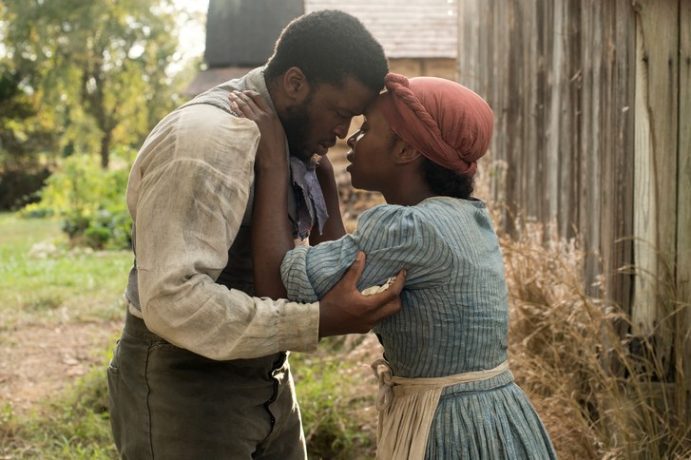
In this sense, the film Harriet feels more like an introductory course to Tubman rather than uncovering new and unique components of her larger than life story. There are more conventional biopics (even ones that have won the last few acting Oscars), but it’s still hard to view Harriet as anything but a fairly straightforward telling of a historical figure. This will work better for some audiences than others. There is a clear heroic structure in place, as we see Harriet start as a soft-spoken woman entrapped by a cruel system, make her own way to freedom, and then find the strength to lead others to a more hopeful future. The most compelling moments are Harriet’s abilities to foresee the future and the somewhat mystical ways in which she could avoid capture. However, many of the daring escape missions are frustratingly simple. Instead of showing Harriet’s full capabilities, most of the time we see her leading escape missions that make it all look a little too easy. There were numerous opportunities for escape sequences ripe for suspense and tension to be filled out further, but instead, they come across as more muted and ordinary. Perhaps I am more critical because I can recall exciting tidbits from history that could’ve propelled these moments to (nearly) Mad Max: Fury Road level suspense, and still done justice to the historical figure.
One exciting thing that Harriet achieves is bringing Harriet Tubman to life beyond a photograph in a book. Nearly every image we know pictures Tubman as being an older woman, yet in Erivo’s performance we see her personified as a young, formidable woman in her late 20s and early 30s. Costume designer Paul Tazewell creates some dazzling (yet period-appropriate) outfits that showcase Tubman as a force to be reckoned with. The costumes are one of the film’s greatest achievements and hope to see them remembered come awards season. Erivo’s performance gets a few moments to shine, though I don’t see this as a star-making performance; some of my favorite moments were the singing voice she brought to the role, which is nicely incorporated into the fabric of the story.
Overall, Harriet is a solid, albeit traditional, biography of a historical figure worthy of being remembered. There are still more dynamic stories to be told of Tubman and her counterparts, and in an era where we are seeing both conventional and groundbreaking biopics exist in tandem, I will always gravitate toward the more boundary-pushing entries. Perhaps before we got an unconventional entry of Harriet Tubman’s life, we needed to have a straightforward outing solidly crafted, and that’s what this film is. From here, I hope to see more work from Kasi Lemmons sooner than later. In the meantime, Harriet will suffice. – H. Nelson Tracey
HARRIET (2019)
Starring: Cynthia Erivo, Leslie Odom Jr., Janelle Monáe, Joe Alwyn
Directed by: Kasi Lemmons
Written by: Gregory Allen Howard, Kasi Lemmons
Distributor: Focus Features
Running time: 125 minutes
Playing: Opening this Friday in theaters everywhere

